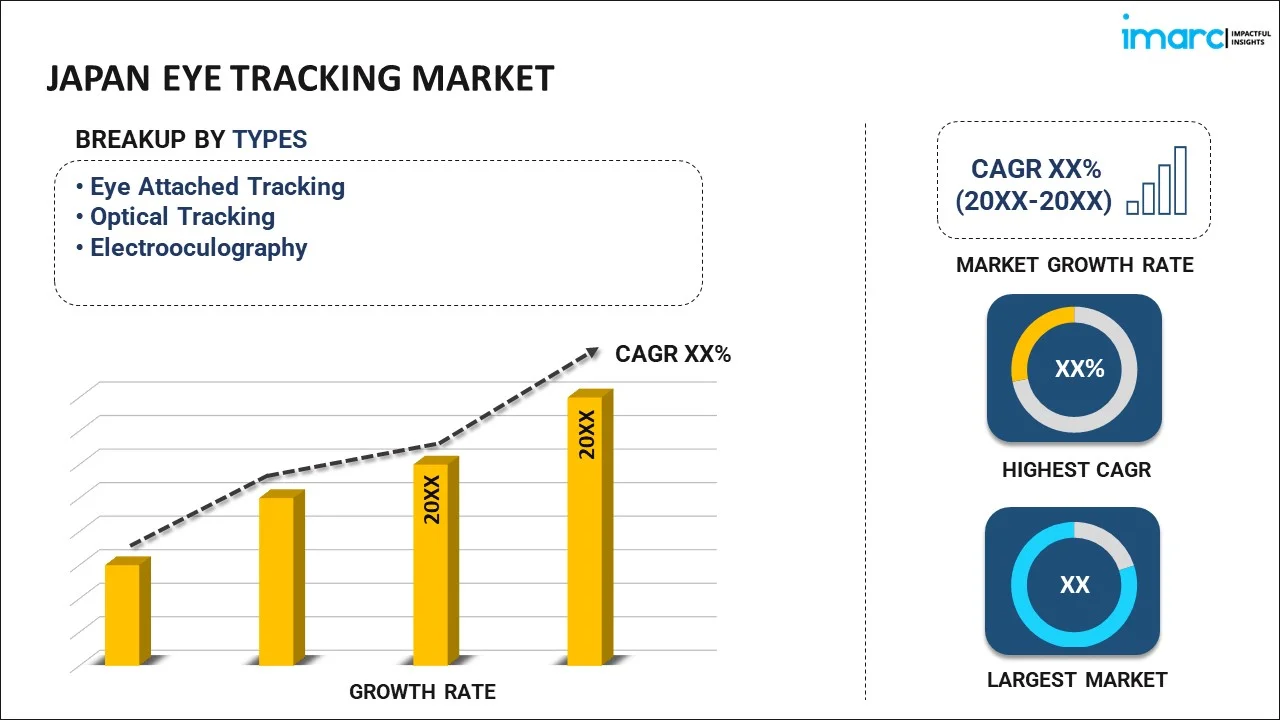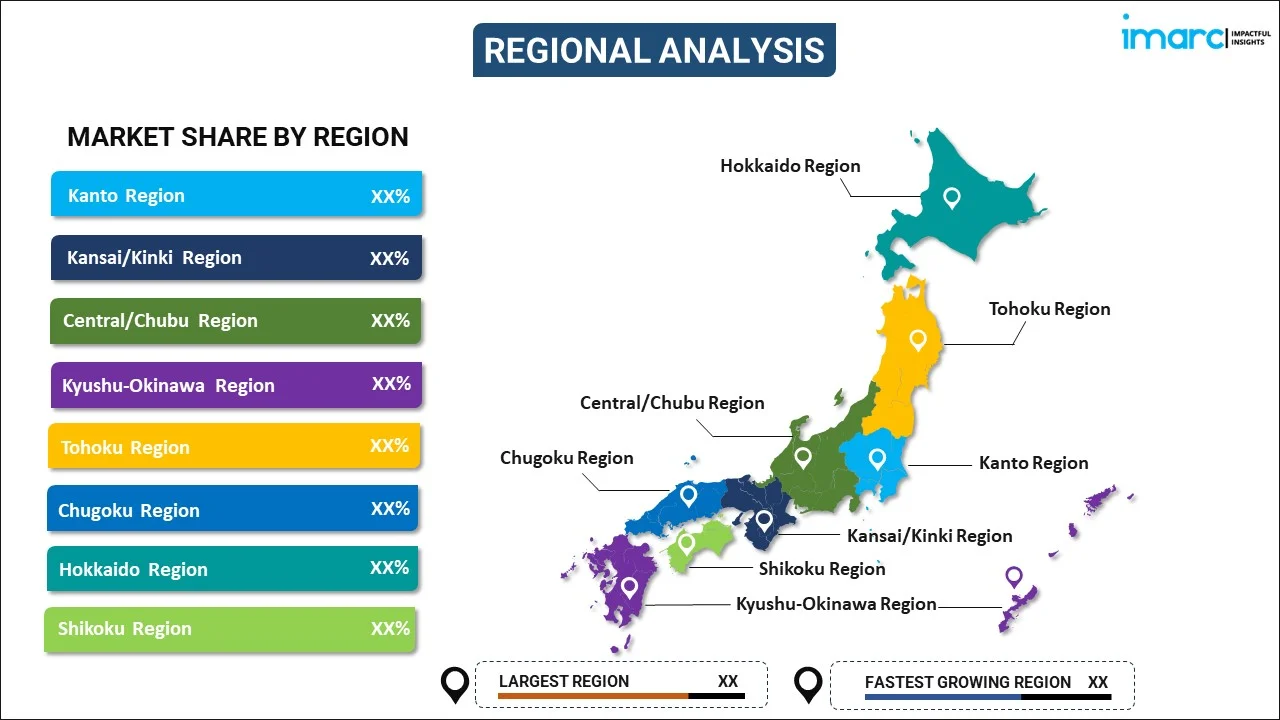
Japan Eye Tracking Market Report by Type (Eye Attached Tracking, Optical Tracking, Electrooculography), Component (Hardware, Software), Location (Remote, Mobile), Application (Healthcare, Retail, Research, Automotive, Consumer Electronics, and Others), and Region 2025-2033
Market Overview:
Japan eye tracking market size reached USD 62.9 Million in 2024. Looking forward, IMARC Group expects the market to reach USD 724.2 Million by 2033, exhibiting a growth rate (CAGR) of 28.7% during 2025-2033. The increasing demand for eye tracking combined with AI and machine learning algorithms, which can provide deeper insights and predictive analytics, is driving the market.
|
Report Attribute
|
Key Statistics
|
|---|---|
|
Base Year
|
2024
|
|
Forecast Years
|
2025-2033
|
|
Historical Years
|
2019-2024
|
| Market Size in 2024 | USD 62.9 Million |
| Market Forecast in 2033 | USD 724.2 Million |
| Market Growth Rate 2025-2033 | 28.7% |
Eye tracking is a technology that monitors and records the movements and positions of a person's eyes to understand their gaze patterns and visual attention. It typically involves the use of specialized equipment, such as eye-tracking cameras or glasses, which can track the precise direction of a person's eye movements. This technology has numerous applications in various fields, including psychology, marketing, user experience research, and human-computer interaction. In psychology, it helps researchers study cognitive processes, such as reading behavior, decision-making, and visual perception. In marketing, it can be used to assess consumer reactions to advertisements and product packaging. In user experience research, it helps designers optimize website and app layouts for better usability. Additionally, eye tracking has practical applications in healthcare, such as diagnosing eye disorders and assisting individuals with disabilities in controlling computers or communication devices. Overall, eye tracking provides valuable insights into human behavior and can improve the design and effectiveness of a wide range of products and experiences.
Japan Eye Tracking Market Trends:
The eye tracking market in Japan is experiencing significant growth, driven primarily by advancements in technology. To begin with, the proliferation of virtual reality (VR) and augmented reality (AR) applications has created a surge in demand for eye tracking technology. As these immersive experiences require precise tracking of user gaze and interaction, eye tracking has become an indispensable component, fueling market expansion. Furthermore, the increasing adoption of eye tracking in various industries like gaming, healthcare, automotive, and advertising underscores its versatility and potential. In gaming, for instance, eye tracking enhances user experiences by enabling more realistic interactions and improving gameplay mechanics. Likewise, healthcare professionals are utilizing eye tracking for diagnostic purposes, monitoring patient eye movements to detect neurological disorders or assess cognitive functions. Moreover, the integration of eye tracking technology into automotive safety systems in response to the growing emphasis on driver safety and the development of autonomous vehicles is expected to drive the market in Japan during the forecast period.
Japan Eye Tracking Market Segmentation: -
IMARC Group provides an analysis of the key trends in each segment of the market, along with forecasts at the country level for 2025-2033. Our report has categorized the market based on type, component, location, and application.
Type Insights:

- Eye Attached Tracking
- Optical Tracking
- Electrooculography
The report has provided a detailed breakup and analysis of the market based on the type. This includes eye attached tracking, optical tracking, and electrooculography.
Component Insights:
- Hardware
- Software
A detailed breakup and analysis of the market based on the component have also been provided in the report. This includes hardware and software.
Location Insights:
- Remote
- Mobile
The report has provided a detailed breakup and analysis of the market based on the location. This includes remote and mobile.
Application Insights:
- Healthcare
- Retail
- Research
- Automotive
- Consumer Electronics
- Others
A detailed breakup and analysis of the market based on the application have also been provided in the report. This includes healthcare, retail, research, automotive, consumer electronics, and others.
Regional Insights:

- Kanto Region
- Kansai/Kinki Region
- Central/ Chubu Region
- Kyushu-Okinawa Region
- Tohoku Region
- Chugoku Region
- Hokkaido Region
- Shikoku Region
The report has also provided a comprehensive analysis of all the major regional markets, which include Kanto Region, Kansai/Kinki Region, Central/ Chubu Region, Kyushu-Okinawa Region, Tohoku Region, Chugoku Region, Hokkaido Region, and Shikoku Region.
Competitive Landscape:
The market research report has also provided a comprehensive analysis of the competitive landscape in the market. Competitive analysis such as market structure, key player positioning, top winning strategies, competitive dashboard, and company evaluation quadrant has been covered in the report. Also, detailed profiles of all major companies have been provided.
Japan Eye Tracking Market Report Coverage:
| Report Features | Details |
|---|---|
| Base Year of the Analysis | 2024 |
| Historical Period | 2019-2024 |
| Forecast Period | 2025-2033 |
| Units | Million USD |
| Scope of the Report | Exploration of Historical Trends and Market Outlook, Industry Catalysts and Challenges, Segment-Wise Historical and Future Market Assessment:
|
| Types Covered | Eye Attached Tracking, Optical Tracking, Electrooculography |
| Components Covered | Hardware, Software |
| Locations Covered | Remote, Mobile |
| Applications Covered | Healthcare, Retail, Research, Automotive, Consumer Electronics, Others |
| Regions Covered | Kanto Region, Kansai/Kinki Region, Central/ Chubu Region, Kyushu-Okinawa Region, Tohoku Region, Chugoku Region, Hokkaido Region, Shikoku Region |
| Customization Scope | 10% Free Customization |
| Post-Sale Analyst Support | 10-12 Weeks |
| Delivery Format | PDF and Excel through Email (We can also provide the editable version of the report in PPT/Word format on special request) |
Key Questions Answered in This Report:
- How has the Japan eye tracking market performed so far and how will it perform in the coming years?
- What has been the impact of COVID-19 on the Japan eye tracking market?
- What is the breakup of the Japan eye tracking market on the basis of type?
- What is the breakup of the Japan eye tracking market on the basis of component?
- What is the breakup of the Japan eye tracking market on the basis of location?
- What is the breakup of the Japan eye tracking market on the basis of application?
- What are the various stages in the value chain of the Japan eye tracking market?
- What are the key driving factors and challenges in the Japan eye tracking?
- What is the structure of the Japan eye tracking market and who are the key players?
- What is the degree of competition in the Japan eye tracking market?
Key Benefits for Stakeholders:
- IMARC’s industry report offers a comprehensive quantitative analysis of various market segments, historical and current market trends, market forecasts, and dynamics of the Japan eye tracking market from 2019-2033.
- The research report provides the latest information on the market drivers, challenges, and opportunities in the Japan eye tracking market.
- Porter's five forces analysis assist stakeholders in assessing the impact of new entrants, competitive rivalry, supplier power, buyer power, and the threat of substitution. It helps stakeholders to analyze the level of competition within the Japan eye tracking industry and its attractiveness.
- Competitive landscape allows stakeholders to understand their competitive environment and provides an insight into the current positions of key players in the market.
Need more help?
- Speak to our experienced analysts for insights on the current market scenarios.
- Include additional segments and countries to customize the report as per your requirement.
- Gain an unparalleled competitive advantage in your domain by understanding how to utilize the report and positively impacting your operations and revenue.
- For further assistance, please connect with our analysts.
 Inquire Before Buying
Inquire Before Buying
 Speak to an Analyst
Speak to an Analyst
 Request Brochure
Request Brochure
 Request Customization
Request Customization




.webp)




.webp)












